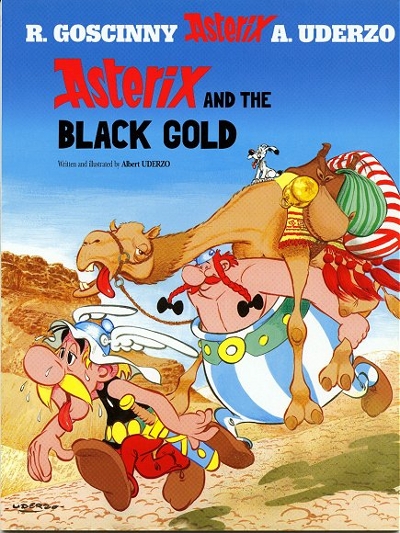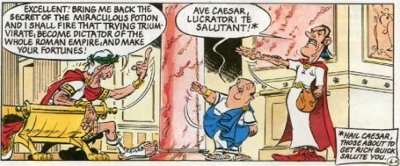|
When Asterix met James Bond

Asterix first appeared in Pilote
magazine in 1959 and has since been translated into 100 languages,
selling over 300 million books. The series revolves around a sleepy
village by the sea in ancient Gaul (a region of Western Europe during
the Iron Age and Roman era which included France - where Asterix is
set) that steadfastly refuses to acknowledge Roman rule because they
have a magic potion brewed by their venerable druid Getafix that gives
the recipient super strength. So any Romans with designs on the village
can expect a magic potion enhanced bashing. Despite the invaders
controlling the outside world (save for the surrounding forest - which
the Gauls consider their own private domain) life there amongst the
little thatched huts goes on as normal with bickering, banquets,
hunting, mass brawls, friendships, gossip, rivalries, celebrations.
The Asterix series was a perfect
unison between the talented and amusing artist Albert Uderzo and the
equally talented and amusing writer René Goscinny (who in terms of
sales must be the two most successful authors France has ever
produced). They met in 1951 and emerged together at a time when the
French comic industry was starting to become irritated by the
increasing pop culture domination of America and expressed a vocal
desire for some patriotic swashbuckling homegrown heroes of their own
to read and enjoy. So together they created Asterix, a diminutive but
cunning and brave yellow pig-tailed Gaulish warrior.
Asterix was surrounded with
memorable supporting characters and this was always a huge part of the
appeal of the books. From his portly boar munching menhir obsessed best
friend Obelix to the long suffering Chief Vitalstatistix (who always
insisted on being carried around on a shield and frequently got
dropped) to Getafix (Panoramix in the French version) the wise druid.
Getafix is one of the greatest characters in the world of Asterix and
like a cross between Gandalf and a hippy with his huge beard, white
robes and golden sickle. Getafix is a humanist and provides moral
guidance in the village. He is like everyone's grandfather. The Gauls
might be near invulnerable with their potion but they are a
superstitious bunch and greatly fear the day when the sky might fall on
their heads so their druid is always a reassuring presence, as of
course is his magic potion, the secret of which is "lost in the mists
of time..."
Not forgetting of course
Unhygienix the fishmonger (instigator of many fish related comic mass
brawls in the village) and Cacofonix the Bard. Cacofonix is the truly
awful singer who thinks he's a genius and - in a funny recurring joke -
is always shown tied up and gagged in the big celebration banquet under
star strewn skies coda that ends each volume so that he can't possibly
sing. I love too the Barbe Rouge inspired pirates who are always being
hopelessly sunk and shipwrecked and in terms of fame quickly surpassed
their Redbeard inspiration.
Asterix is broader and more
'comic book' than Tintin and often seems simplistic on the face of it,
never seeming to deviate too much from the staple elements. But look
closer and there is much clever and subtle material. The riffs on real
historical events, works of art, paintings, the cultural references
(Fellini, James Bond, Laurel & Hardy etc), even an ecological
message and some rather poignant moments. In The Mansions of the Gods,
Asterix and Getafix walk in the forest amongst the trees in fading
light and wonder if the magical forest will even be there one day as
logging and civilisation spreads its ugly tentacles. Getafix tells
Asterix that all they can do is enjoy the forest and what time they
have while they can.
Asterix is a comic farce and
big, bold and colourful but it could be surprisingly thoughtful and
even adult and strange (the man being whipped during the "cheese orgy"
scene in Asterix in Switzerland). The depiction of Julius Caesar in
Asterix in particular is very interesting and cleve. Although he rages
and plots against the Gauls he is not a merciless dictator or ever made
to look completely foolish for too long. He even shows kindness and
generosity when the Gauls perform a deed he considers to be noble. The
most important thing is that he remains more than a mere one
dimensional character and a worthy opponent for Asterix and the Gauls.
Asterix is possibly something of
an acquired taste but the wonderfully cosy art by Uderzo is always
superb and these books are remarkably clever at times beneath the
surface. What other comic would reference The Anatomy Lesson of Dr Tulp
by Rembrandt or the Peasant Wedding Feast by Pieter Breugel the Elder.
Perhaps the most genius element is the historical time period of the
books. Albert Uderzo's Roman and Gaulish interiors in particular remain
fantastic. I absolutely want to live in that Gaul village by the sea
with its cosy firelit huts and sleepy way of life. When Goscinny died
in 1977 and Uderzo took over the writing duties in addition to his
artistic obligations the series was sadly never quite the same again.
One bright spot though is Asterix and the Black Gold, the second volume
to be written and illustrated by Uderzo alone after the death of René
Goscinny. Asterix and the Black Gold is fun for Bond fans in particular
because of the James Bond riffs and the presence of an obvious Sean
Connery caricature secret agent in the story.
Asterix and the Black Gold is
the twenty-sixth book in the series and was published in 1981. The
story begins with Asterix and Obelix hunting a couple of boars in the
forest and accidently running into some Romans. The boars have learnt
to lead the Gauls to Roman patrols so they can escape ending up as
someone's dinner (the Gauls can't resist fighting the Romans and the
boars can therefore escape in the resulting carnage) but the Romans
assume the Gauls have trained the boars to do this. 'That Amorican
village is still holding up the might of Rome to ridicule me,' grumbles
Julius Caesar when he is told. 'And I hear that my legions now have to
face hordes of wild beasts!' Devius Surreptitious, the head of the
Roman Secret Service, tells Caesar they must get hold of the secret of
the Gaul magic potion which makes them invincible and explains that a
druid would have the best chance of doing this. It just so happens he
has a brilliant secret agent druid known as Dubbelosix and Dubbelosix
is promptly sent off to infiltrate the Gaul village where Asterix lives.

Meanwhile, the Gaul druid
Getafix is looking very worried and preoccupied and some of the
villagers are starting to become concerned about him. It turns out
Getafix is desperately awaiting the arrival of the ship belonging to
Ekonomikrisis the Phoenician merchant because he has run out of rock
oil. Rock oil is a vital ingredient in his magic potion but when
Ekonomikrisis finally turns up he confesses he forgot all about the
rock oil and doesn't have any. Getafix collapses in shock and when he
recovers tells Vitalstatstix, Asterix, Obelix and Dubbelosix (who met
Asterix and Obelix in the forest in his druid garb and was asked to
treat Getafix) that with no magic potion they will now be defenceless
against the Romans. There is only one solution. Asterix and Obelix must
go to Mesopotamia and bring back some rock oil and Dubbelosix offers to
go with them to help. Will our heroes work out that Dubbelosix is a
Roman agent out to sabotage their vital mission?
As far as the post-Goscinny
books rank, Asterix and the Black Gold is certainly the finest hour of
Uderzo and an entertaining entry in the series with some highly
enjoyable art. One thing I liked about the story in particular was the
abundance of James Bond related jokes. Dubbelosix is drawn to look like
a Zardoz caricature of Sean Connery and has a spiffy chariot that
assembles itself and is packed with gadgets. There's a great bit where
he's with Asterix and Obelix and deploying some of these while Romans
chase after them. He rides off a cliff into the sea looking very
nonchalant and unworried but the chariot and its three occupants just
crash into the water with a big splash. 'Something should have happened
when I pressed that button!' he tells an annoyed and wet looking
Asterix and Obelix. The Roman secret service run by Devius
Surreptitious is called M.I.VI. (a pun on MI6) and Dubbelosix treats (a
soon to be very merry) Getafix with a 'grain spirit called Caledonian'
which he muses might be better diluted with a spot of soda!
There are some nice gimmicks in
the story here, like the way that Dubbelosix keeps in touch with
Surreptitious via a trained female carrier fly that just happens to be
love with him. There are even a few nods to Mission Impossible in
amongst all the spy related jokes and references. Asterix and the Black
Gold works because it has a good story and Uderzo has clearly put an
awful lot of effort into the art. This really feels like a big
old-fashioned epic Asterix adventure in the vein of the ones he
produced in partnership with the late Goscinny. Uderzo went to Israel
to do some research for the book and there are many lovely panels as a
result. There is a wonderful illustration of Jerusalem from above that
catches the eye and some of the night panels are excellent. 'Bethlehem,
I think,' replies Dubbelosix when Asterix asks them the name of the
village where they are currently having a nap in a stable under the
moonlight.
The standard is set early here
with the mystery of why Getafix is so gloomy and the wonderful panels
of him looking out to sea, anxiously awaiting the arrival of
Ekonomikrisis the Phoenician merchant as the sun rises and sets. There
is a great drawing of Asterix hiding on the rocks behind him trying to
see what the problem is and some wonderful art generally in Asterix and
the Black Gold with the walls of ancient cities, silhouettes of ships
beneath a red sky and Uderzo's Roman interiors, which are always a
delight. There are some enjoyable capers at sea here too with Asterix
and Obelix taking on the comically rubbish pirates who feature in most
of the books in a recurring joke and also smashing up a Roman galley or
two, which they are equally delighted to run into. There's an amusing
side panel by Uderzo as a prelude to all of this carnage. 'We now have
a chance to observe the superbly efficient boarding tactics practiced
by the Roman Navy. First ballistae throw out the grappling hooks...'
As a later solo Uderzo effort I
expected Asterix and the Black Gold to be one of the lesser entries but
it's a surprisingly good adventure on the whole with an excellent
story, some lovely art and a great deal of invention. The James Bond
jokes and the presence of Dubbelosix drawn to look like Sean Connery
adds to the fun. This is a nice read for Asterix and James Bond fans of
all ages.
- Jake
c 2016
Alternative 007
|

|


